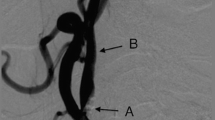Abstract
Carotid stenting is a percutaneous, minimally invasive treatment for carotid stenosis. It does not carry the surgical risks of carotid endarterectomy and therefore can be applied to the elderly and to patients with comorbidities. Complications and late events appear low.
Similar content being viewed by others
References
Zeitter E, Gruntzig A. Percutaneous recanalization. In: Schoop W, ed.Percutaneous Angioplasty. Berlin, Germany: Springer; 1978.
North American Symptomatic Carotid Endarterectomy Trial collaborators. Beneficial effect of carotid endarterectomy in symptomatic patients with high-grade carotid stenosis.N Engl J Med. 1991;325:445–453.
Barnett HJ, Taylor, DW, Eauszw, M, et al for the North American Symptomatic Carotid Endarterectomy Trial collaborators. Benefit of carotid endarterectomy in patients with symptomatic moderate or severe stenosis.N Engl J Med. 1998;339:1415–1425.
Executive Committee for the Asymptomatic Carotid Atherosclerosis Study. Endarterectomy for asymptomatic carotid artery stenosis.JAMA. 1995;273:1421–1428.
Tu JV, Hannan EL, Anderson GM, et al. The fall and rise of carotid endarterectomy in the United States and Canada.N Engl J Med. 1998;339:1441–1447.
European Carotid Surgery Trialists’ Collaborative Group. MRC European Carotid Surgery Trial: interim results for symptomatic patients with severe (70–99%) or with mild (0–29%) carotid stenosis.Lancet. 1991;337:1235–1243.
European Carotid Surgery Trialists’ Collaborative Group. Randomised trial of endarterectomy for recently symptomatic carotid stenosis: final results of the MRC European Carotid Surgery Trial (ECST).Lancet. 1998;351:1379–1387.
Brott T, Thalinger K. The practice of carotid endarterectomy in a large metropolitan area.Stroke. 1984;15:950–955.
Rothwell PM, Slattery J, Warlow CP. A systematic review of the risks of stroke and death due to endarterectomy for symptomatic carotid stenosis.Stroke. 1996;27:260–265.
Cebul RD, Snow RJ, Pine R, Hertzer NR, Norris DG. Indications, outcomes, and provider volumes for carotid endarterectomy.JAMA. 1998;279:1282–1287.
Hennerici M, Daffertshofer M, Meairs S. Concerns about generalisation of premature ACAS recommendations for carotid endarterectomy.Lancet. 1995;346:1041.
Wennberg DE, Lucas FL, Birkmeyer JD, Bredenberg CE, Fisher ES. Variation in carotid endarterectomy mortality in the Medicare population: trial hospitals, volume, and patient characteristics.JAMA. 1998;279:1278–1281.
Sundt TMJ, Meyer FB, Piepras DG, Fodee NG, Ebersold NJ, Marsh WR. Risk factors and operative results. In: Meyer FB, ed.Sundt’s Occlusive Cerebrovascular Disease. 2nd ed. Philadelphia, Pa: WB Saunders Co: 1994:241–247.
McCrory DC, Goldstein LB, Samsa GP, et al. Predicting complications of carotid endarterectomy.Stroke. 1993;24:1285–1291.
Antiplatelet Trialists’ Collaboration. Collaborative overview of randomised trials of antiplatelet therapy—I: Prevention of death, myocardial infarction, and stroke by prolonged antiplatelet therapy in various categories of patients.Br Med J. 1994;308:81–106.
Shinton R, Beevers G. Meta-analysis of relation between cigarette smoking and stroke.Br Med J. 1989;298:789–794.
Collins R, Peto R, MacMahon S, et al. Blood pressure, stroke, and coronary heart disease: II. Short-term reductions in blood pressure: overview of randomised drug trials in their epidemiological context.Lancet. 1990;335:827–838.
Sacks FM, Pfeffer MA, Moye LA, et al for the Cholesterol and Recurrent Events Trial investigators. The effect of pravastatin on coronary events after myocardial infarction in patients with average cholesterol levels.N Engl J Med. 1996;335:1001–1009.
Yadav JS, Roubin GS, Iyer S, et al. Elective stenting of the extracranial carotid arteries.Circulation. 1997;95:376–381.
Mathur A, Roubin GS, Iyer SS, et al. Predictors of stroke complicating carotid artery stenting.Circulation. 1998;97:1239–1245.
Mathur A, Roubin GS, Gomez CR, et al. Elective carotid artery stenting in the presence of contralateral occlusion.Am J Cardiol. 1998;81:1315–1317.
Hobson RW II, Brott T, Ferguson R, et al. CREST: carotid revascularization endarterectomy vs stent trial.Cardiovasc Surg. 1997;5:457–458.
Author information
Authors and Affiliations
About this article
Cite this article
New, G., Roubin, G.S., Iyer, S.S. et al. Carotid artery stenting: Rationale, indications, and results. Compr Ther 25, 438–445 (1999). https://doi.org/10.1007/BF02944296
Received:
Accepted:
Issue Date:
DOI: https://doi.org/10.1007/BF02944296




